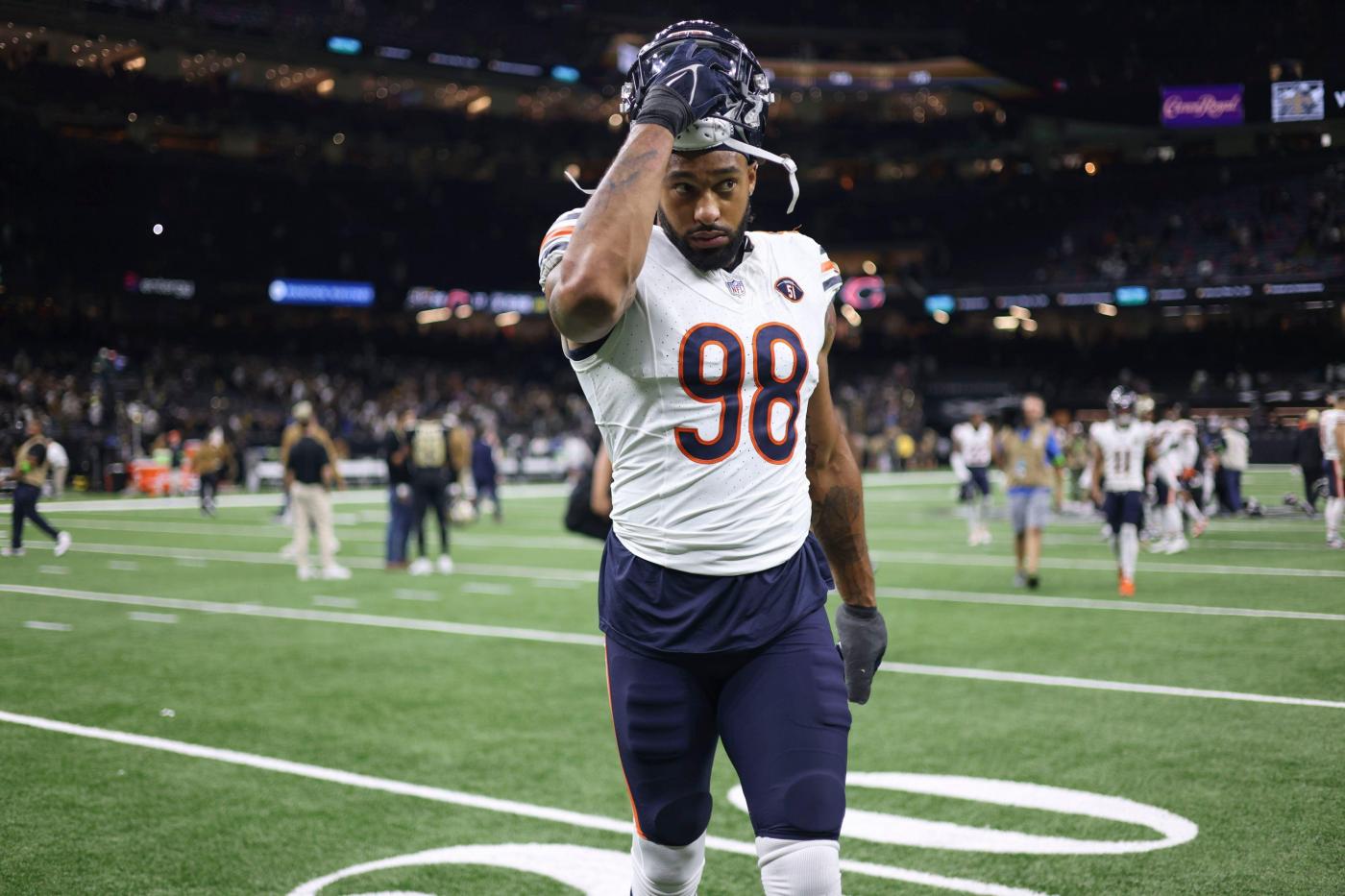
Column: Montez Sweat’s big contract with the Chicago Bears gives him security — and with it comes big-time pressure
At least Montez Sweat has his bearings now.
He doesn’t know the names of plenty of folks at Halas Hall yet, maybe even a few Chicago Bears teammates. But he can navigate the building, which wasn’t the case when he was introduced Nov. 1 before even learning where the locker room was.
Sweat has had eight practices and played in two games with the Bears before their NFC North matchup Sunday against the Detroit Lions at Ford Field. He sneaked in a trip home to Atlanta last weekend with the extended time off following the Thursday night game and saw his 1 1/2-year-old son, Shiloh.
But it has been a whirlwind of a life-changing experience — he signed a four-year, $98 million extension four days after the Halloween trade, with the Bears sending the Washington Commanders a second-round pick.
As Sweat continues to settle in to his new environment, does he have a greater sense of relief, or is he feeling pressure now that he’s one of the highest-paid edge rushers in the NFL?
“Definitely a little bit of both,” he said. “There is security there and, yeah, it’s really hunger. It’s more fuel just to show I’m the type of player I am being paid like.”
Security comes from the fact that if Sweat were to suffer a serious injury, he’s taken care of and doesn’t need to worry about cashing in on the 3 1/2 seasons of hard work he put in on the field. Pressure comes from the fact that to whom much is given, much is expected, especially as a member of a defense that has been unable to harass opposing quarterbacks for two years running.
Sweat’s contract averages $24.5 million per season. Only Nick Bosa, T.J. Watt, Joey Bosa and Myles Garrett have a higher APY. Of the top-15 edge rushers in APY, Sweat and Rashan Gary of the Green Bay Packers are the only ones not to have at least one season with double-digit sacks. Sweat had nine in 2020. Gary, who signed a four-year, $96 million extension last month, had 9 1/2 in 2021.
“The relief part is cool,” Sweat said. “Pressure? All of these guys (motioning to teammates throughout the locker room), we’ve all got a job to do on Sundays. I expect everybody to try to do their job to the best of their ability just like I am. Pressure is privilege.”
It’s not as if Sweat doesn’t know the feeling. He felt it in Washington when he was drafted in the first round in 2019, one of four first-round draft picks on the Commanders defensive line over a four-year stretch. And pressure comes in all forms. Undrafted players don’t have a signing bonus to play up to — but they’re under constant scrutiny to keep a spot on the roster. Sweat’s point is he isn’t like anyone else on the roster in that regard.
While it would be foolish to pass judgment on the trade just two games in, early results have been positive. Sweat had five pressures and three quarterback hits on Bryce Young in the 16-13 victory against the Carolina Panthers.
That type of production should turn into sacks — Sweat had 6 1/2 for the Commanders before the trade — and create opportunities for defensive teammates. Ultimately that propelled general manager Ryan Poles to make the trade and double down by paying Sweat. He is viewed as a multiplier, the kind of elite performer who raises the level of play of those around him.
Defensive tackle Justin Jones had arguably his best game of the season against the Panthers with three solo tackles, one sack and three QB hits. Rookies Gervon Dexter and Zacch Pickens made an impact. Dexter had a hit and Pickens drew a holding penalty. It might have been the best game of the season for rotational rusher Rasheem Green, and Yannick Ngakoue picked up his third sack of the season and first since Week 5.
But to be very clear, more work must be done to get this defensive line where the Bears need it from a personnel standpoint, and Sweat is the first major building block while the team waits to see how younger players develop.
The Bears have a challenge this week — the Lions do a nice job of protecting quarterback Jared Goff. He’s got a sack percentage of 4.4%, fifth-best in the league, and Sweat likely will be going against third-year right tackle Penei Sewell, one of the best in the NFL, for most of the game.
Coach Matt Eberflus drew a parallel to the situation in Indianapolis, when he was defensive coordinator and the Colts traded a first-round pick to the San Francisco 49ers for defensive tackle DeForest Buckner, a disruptive interior player.
“Very similar,” Eberflus said. “That’s a premier player, All-Pro player and a guy who can affect the quarterback. You can really see the effect. The Tez factor that I called it the other day or the Tez effect. You can see the rushers work at the quarterback. We had a lot of good pressures last week, a lot of good hits on the quarterback, a few sacks. That’s got to continue. It really helped our coverage. You can see that. A lot of the incomplete passes were definitely created by that pressure. We’ve got to continue that.”
Sweat said as he was transitioning to being a defensive end — he was recruited out of high school as a tight end — he watched video of former Bears edge rusher Julius Peppers.
“Just the way he used his length to get off,” Sweat said. “The way he sheds from tackles and stuff. He had a motor.”
Sweat also tried to pattern some of the moves Khalil Mack, another former Bear, has perfected.
“I like his long arm,” he said. “The way he uses it and torques his body. All of those guys have some similar things and they’ve all got motors.”
Pass rushers with elite length — Sweat has a wingspan of 84 3/4 inches — use a straight arm move to keep the offensive lineman from getting their hands into the chest. It creates separation — just like long arms give a boxer an advantage — and allows the edge rusher to gain leverage on what are speed-to-power rushes.
Sweat was effective with his long-arm moves against Panthers right tackle Taylor Moton and the week before against the New Orleans Saints’ Ryan Ramczyk. The hope at Halas Hall is that Sweat is just beginning to transform the defensive front with sacks to come.
“A lot of guys really focus on sacks a lot,” Sweat said. “And it’s a great tool to be judged by, but there’s a lot of other ways to affect the game rather than just getting a sack, whether it’s a hit, a pressure or even being stout in the run game. Any of those things can help you out a lot.”
()


